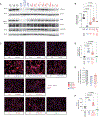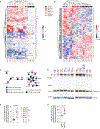Human OTULIN haploinsufficiency impairs cell-intrinsic immunity to staphylococcal α-toxin
- PMID: 35587511
- PMCID: PMC9233084
- DOI: 10.1126/science.abm6380
Human OTULIN haploinsufficiency impairs cell-intrinsic immunity to staphylococcal α-toxin
Abstract
The molecular basis of interindividual clinical variability upon infection with Staphylococcus aureus is unclear. We describe patients with haploinsufficiency for the linear deubiquitinase OTULIN, encoded by a gene on chromosome 5p. Patients suffer from episodes of life-threatening necrosis, typically triggered by S. aureus infection. The disorder is phenocopied in patients with the 5p- (Cri-du-Chat) chromosomal deletion syndrome. OTULIN haploinsufficiency causes an accumulation of linear ubiquitin in dermal fibroblasts, but tumor necrosis factor receptor-mediated nuclear factor κB signaling remains intact. Blood leukocyte subsets are unaffected. The OTULIN-dependent accumulation of caveolin-1 in dermal fibroblasts, but not leukocytes, facilitates the cytotoxic damage inflicted by the staphylococcal virulence factor α-toxin. Naturally elicited antibodies against α-toxin contribute to incomplete clinical penetrance. Human OTULIN haploinsufficiency underlies life-threatening staphylococcal disease by disrupting cell-intrinsic immunity to α-toxin in nonleukocytic cells.
Conflict of interest statement
Figures







Comment in
-
OTULIN Haploinsufficiency Causes Hyperinflammatory Responses to Infectious and Non-Infectious Triggers.J Clin Immunol. 2024 Apr 5;44(4):95. doi: 10.1007/s10875-024-01700-1. J Clin Immunol. 2024. PMID: 38578307 No abstract available.
Similar articles
-
Staphylococcus aureus Alpha-Toxin Limits Type 1 While Fostering Type 3 Immune Responses.Front Immunol. 2020 Aug 7;11:1579. doi: 10.3389/fimmu.2020.01579. eCollection 2020. Front Immunol. 2020. PMID: 32849537 Free PMC article.
-
CD36 Is Essential for Regulation of the Host Innate Response to Staphylococcus aureus α-Toxin-Mediated Dermonecrosis.J Immunol. 2015 Sep 1;195(5):2294-302. doi: 10.4049/jimmunol.1500500. Epub 2015 Jul 29. J Immunol. 2015. PMID: 26223653 Free PMC article.
-
OTULIN Haploinsufficiency-Related Fasciitis and Skin Necrosis Treated by TNF Inhibition.J Clin Immunol. 2023 Dec 22;44(1):10. doi: 10.1007/s10875-023-01630-4. J Clin Immunol. 2023. PMID: 38129331
-
Staphylococcus aureus α-toxin: nearly a century of intrigue.Toxins (Basel). 2013 Jun;5(6):1140-66. doi: 10.3390/toxins5061140. Toxins (Basel). 2013. PMID: 23888516 Free PMC article. Review.
-
[In vitro and in vivo efficacy of a toxin-neutralizing human staphylococcal immunoglobulin].Behring Inst Mitt. 1990 Oct;(86):170-84. Behring Inst Mitt. 1990. PMID: 2252461 Review. German.
Cited by
-
Phenotypic and genomic analysis of the hypervirulent methicillin-resistant Staphylococcus aureus ST630 clone in China.mSystems. 2024 Sep 17;9(9):e0066424. doi: 10.1128/msystems.00664-24. Epub 2024 Aug 19. mSystems. 2024. PMID: 39158330 Free PMC article.
-
OTULIN deficiency: focus on innate immune system impairment.Front Immunol. 2024 May 7;15:1371564. doi: 10.3389/fimmu.2024.1371564. eCollection 2024. Front Immunol. 2024. PMID: 38774872 Free PMC article. Review.
-
From second thoughts on the germ theory to a full-blown host theory.Proc Natl Acad Sci U S A. 2023 Jun 27;120(26):e2301186120. doi: 10.1073/pnas.2301186120. Epub 2023 Jun 12. Proc Natl Acad Sci U S A. 2023. PMID: 37307437 Free PMC article.
-
Human determinants of age-dependent patterns of death from infection.Immunity. 2024 Jul 9;57(7):1457-1465. doi: 10.1016/j.immuni.2024.05.020. Immunity. 2024. PMID: 38986441 Free PMC article. Review.
-
Staphylococcus aureus host interactions and adaptation.Nat Rev Microbiol. 2023 Jun;21(6):380-395. doi: 10.1038/s41579-023-00852-y. Epub 2023 Jan 27. Nat Rev Microbiol. 2023. PMID: 36707725 Free PMC article. Review.
References
-
- Lowy FD, Staphylococcus aureus infections. N Engl J Med 339, 520–532 (1998). - PubMed
-
- Gillet Y et al., Association between Staphylococcus aureus strains carrying gene for Panton-Valentine leukocidin and highly lethal necrotising pneumonia in young immunocompetent patients. Lancet 359, 753–759 (2002). - PubMed
-
- Hidron AI, Low CE, Honig EG, Blumberg HM, Emergence of community-acquired meticillin-resistant Staphylococcus aureus strain USA300 as a cause of necrotising community-onset pneumonia. Lancet Infectious Diseases 9, 384–392 (2009). - PubMed
-
- Lina G et al., Involvement of Panton-Valentine leukocidin-producing Staphylococcus aureus in primary skin infections and pneumonia. Clin Infect Dis 29, 1128–1132 (1999). - PubMed
MeSH terms
Substances
Grants and funding
LinkOut - more resources
Full Text Sources
Medical
Molecular Biology Databases

